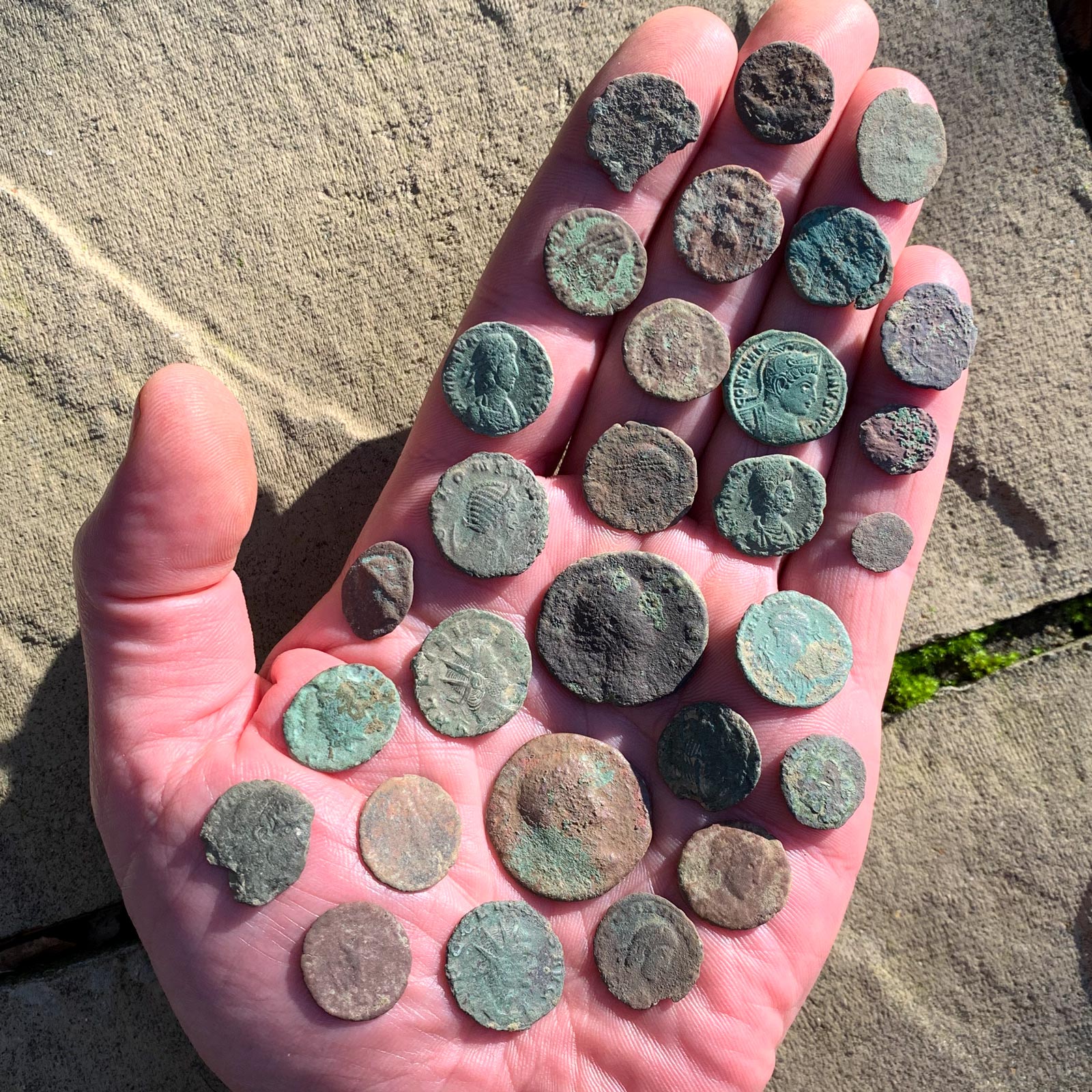
all noisy on the weston front
I’m sure most detectorists would agree that the hardest part of our hobby is obtaining permissions. I have been trying so hard for the past few years to get my own permissions outside of the couple of fields that my family owns but to no avail. I will carry on trying as I’m not the type of person who gives up that easily, but luckily for me I have an old school mate who has been more than generous by taking me out on his permissions. The last article I wrote about the lack of Roman finds at a villa site in Hertfordshire was one of his permissions and the article you’re reading now is much the same situation. But the difference here is that we started searching this site together, so from the off it felt like a level playing field, we both had contact with the landowner and we both arranged times to go detecting.
From the outset I had high hopes of good finds from this permission because the landowner revealed that the farm had been in his family for over 300 years and they had never granted permission for anyone to detect before now. He also revealed that there is a scheduled Roman villa in a neighbouring landowners field which borders with their land, could this permission get any better? Well actually yes, the landowner grows a hay crop so over the autumn and winter months most of the land is left to pasture, it is literally like being on the set of detectorists, heaven! Things did get a bit childish on the first day though when my old mate said “bagsie I get the field next to the Roman Villa”, at which point I started running whilst shouting “last one there’s not allowed on for a month!”. Things haven’t really progressed much from the school playground in the past 50 years.
The playground tactics employed to gain sole access to this particular field were soon to be proven pointless. On paper this should have been the field that produced the most given its close proximity to the villa, but in the 8 months that we have been on this permission it’s the field that has produced the least. I initially put this down to the fact that we started searching in the middle of summer with dry hard ground being a factor in masking what lay beneath. But even during the autumn and winter months when the ground was wet and soft it still didn’t really produce that much.
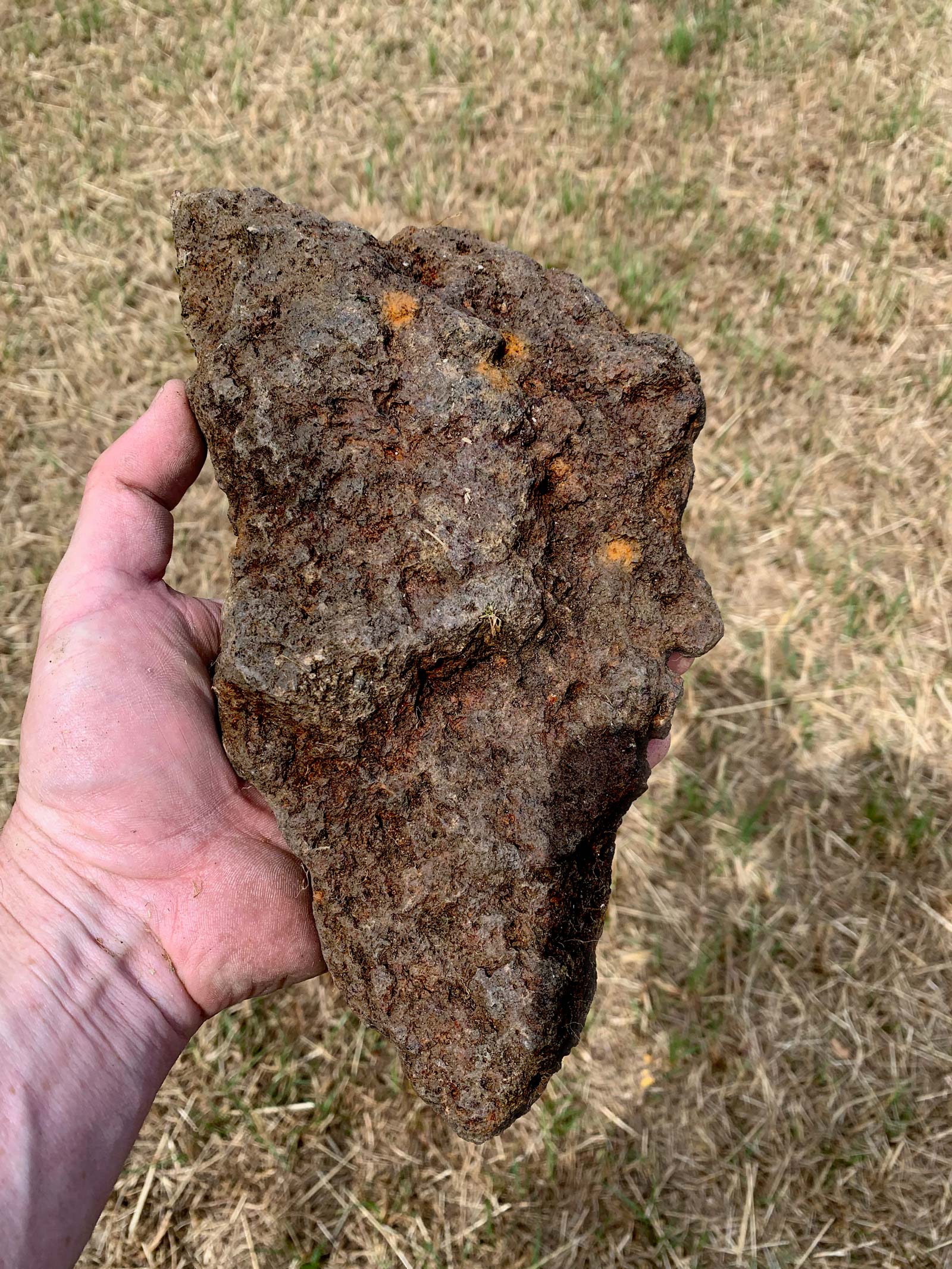
A large lump of iron slag.
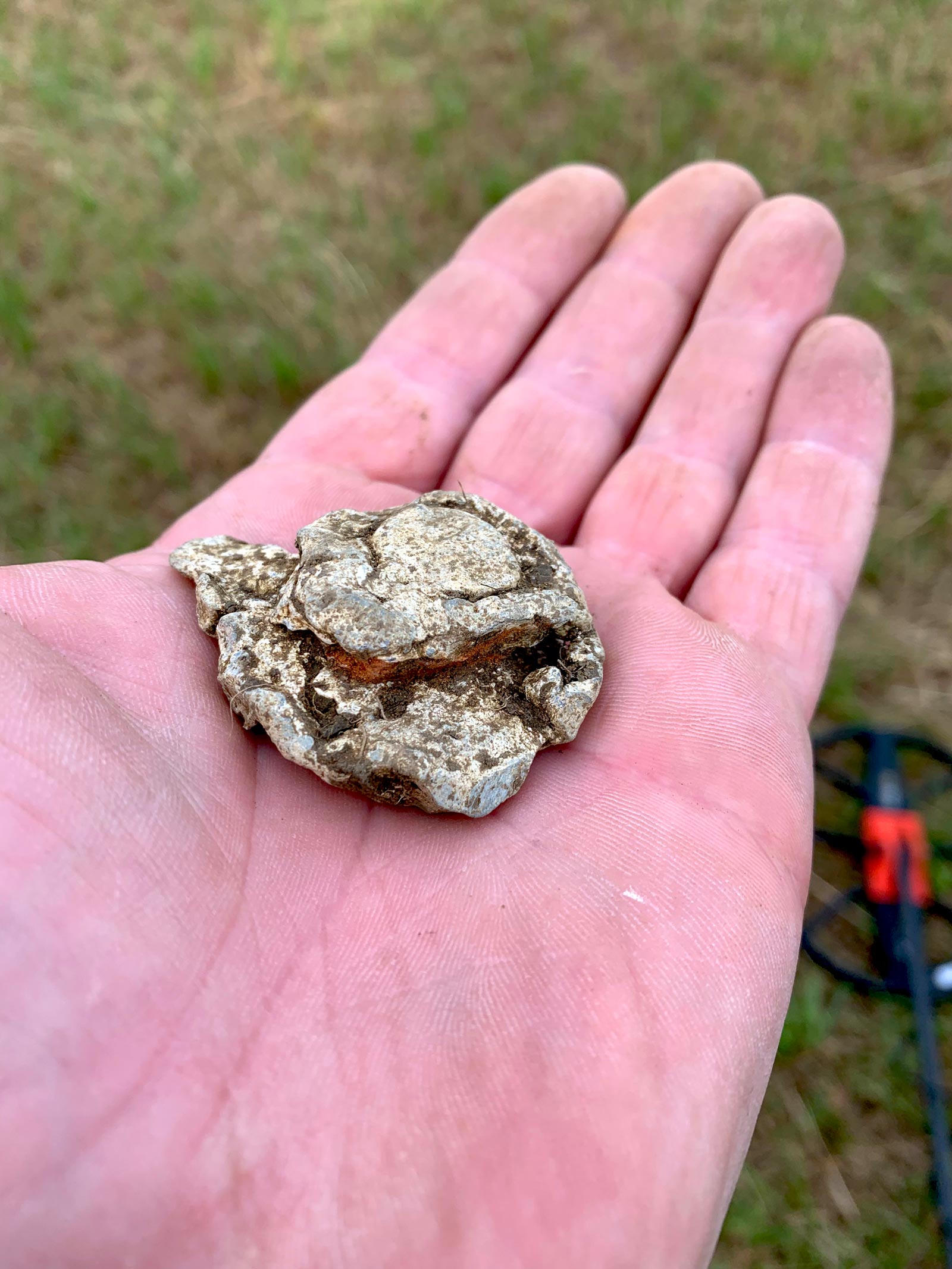
A pretty big lead pot mend.
That’s not to say it produced nothing, in between the vast array of shot gun cartridges there has been the odd grotty Roman coin (5 in total between us), a huge lead pot mend and a massive lump of iron slag, all things which could be related to the villa in the next field. There has also been a few modern-ish coins including my first George III penny, even though it was pretty toasted it was still a joy to find.
The permission itself is pretty big, with a gorgeous 16th century country home at the heart of it. There is a lot of land here for us to search and given that it stretches between the Roman villa and a 12th century parish church there should be a lot of history for us to find. Our next target was a huge south facing slope which as luck would have it had just been harvested and was now left to pasture. My mate got chatting to a lady that used to help out farming this land and she told him that the south facing slope was referred to as ‘the vineyard’, could this be a Roman legacy?
I think it’s fair to say that this is where the historical journey really began as the finds started reveal the history we hoped that this permission would hold. My mate started things off on the first outing with a couple of hammy’s, but I wasn’t really getting that much in way of good signals. There is hardly any iron trash on this particular field so I soon learned that when I did get a signal it would more often than not be something good. Then on the 2nd outing I had some Roman coins come up, firstly a denarius of Hadrian which was a little beaten up but easily identifiable. Then I had a very worn dupondius which was closely followed by a lovely silver denarius of Faustina Sr. Because this was the first silver Roman I had found on this permission I decided to give it back to the land owner as he has a real interest in the history of his land.
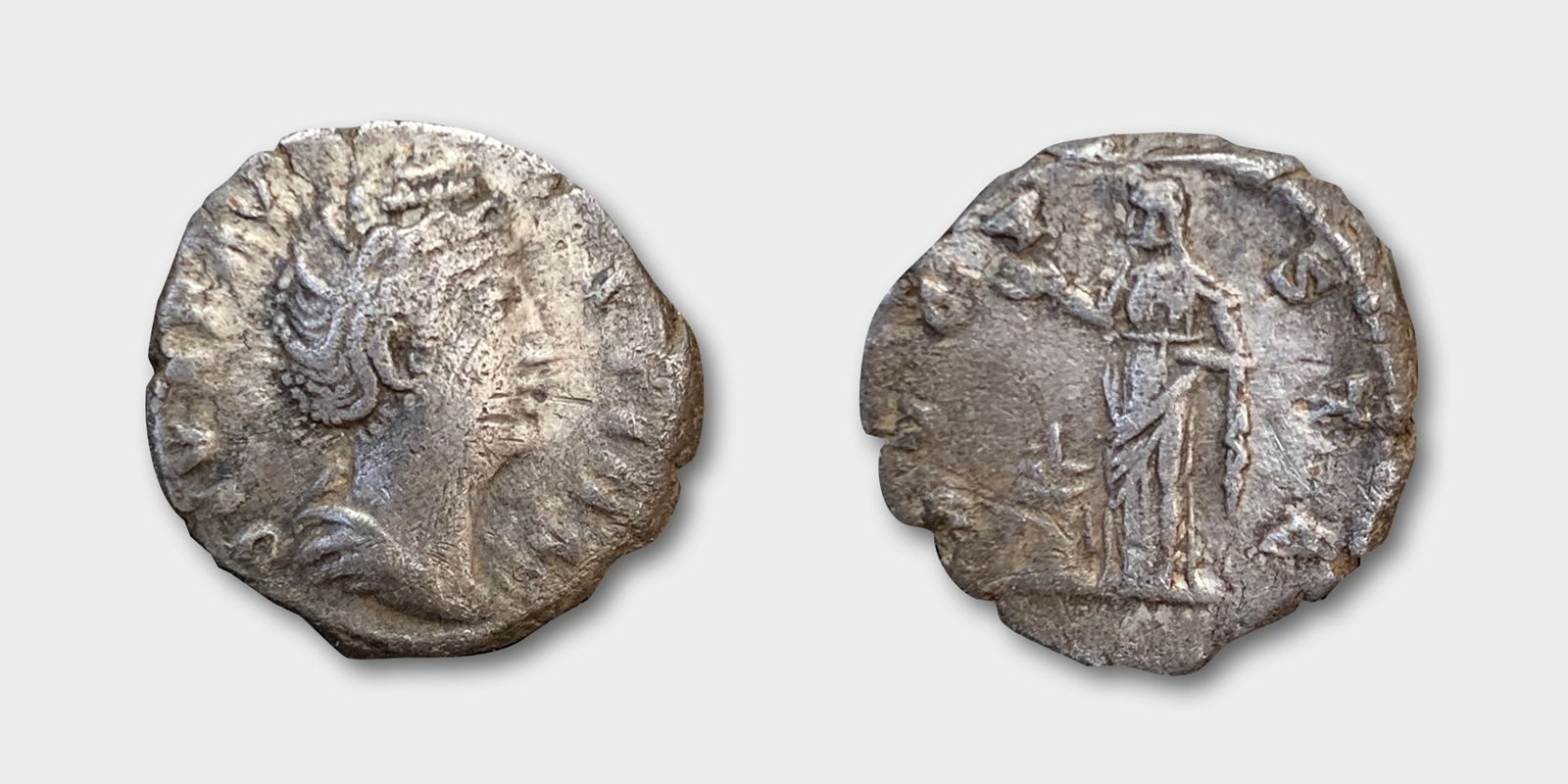
Faustina Senior 146-161AD.
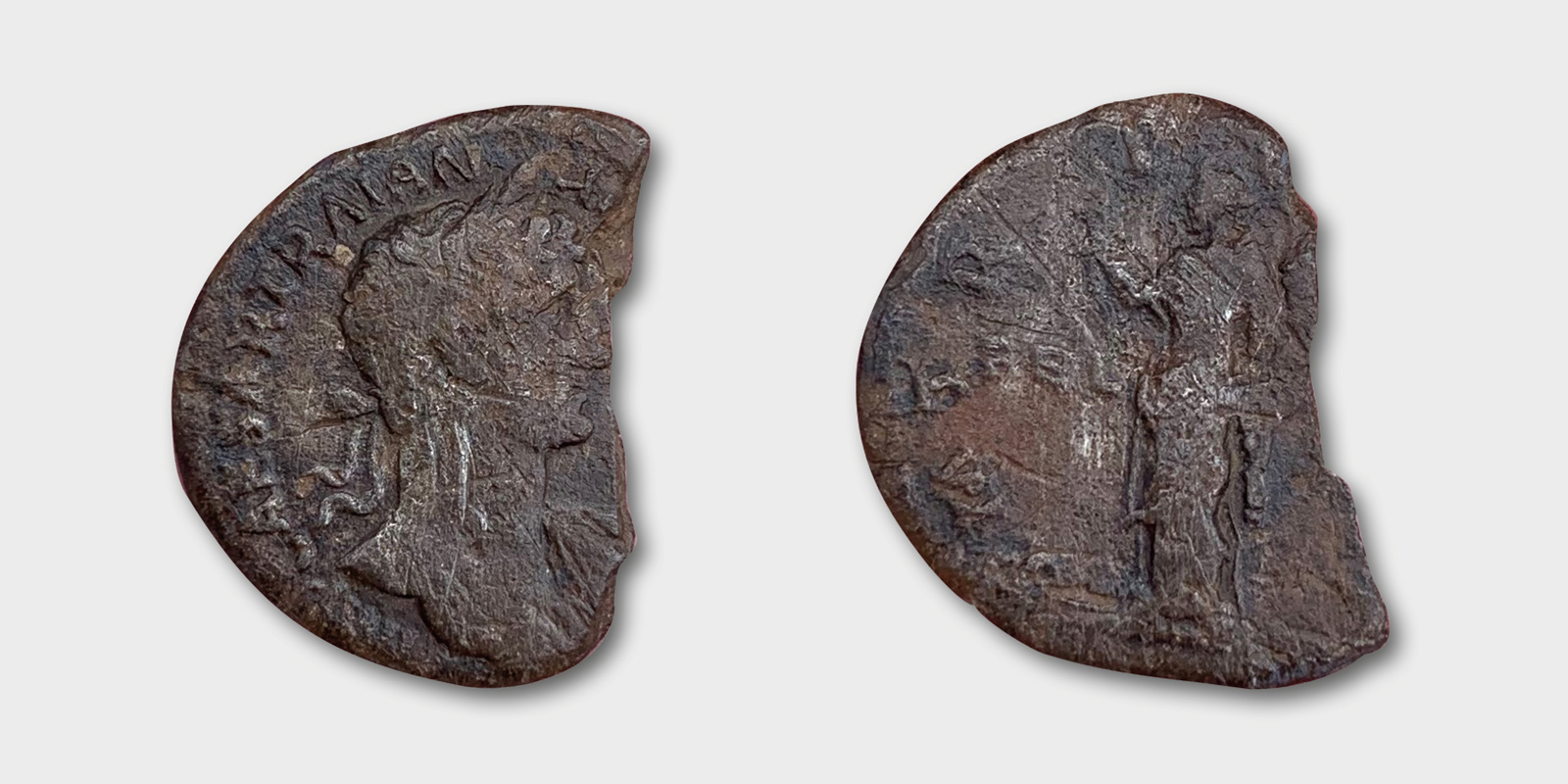
Hadrian 117-138AD.
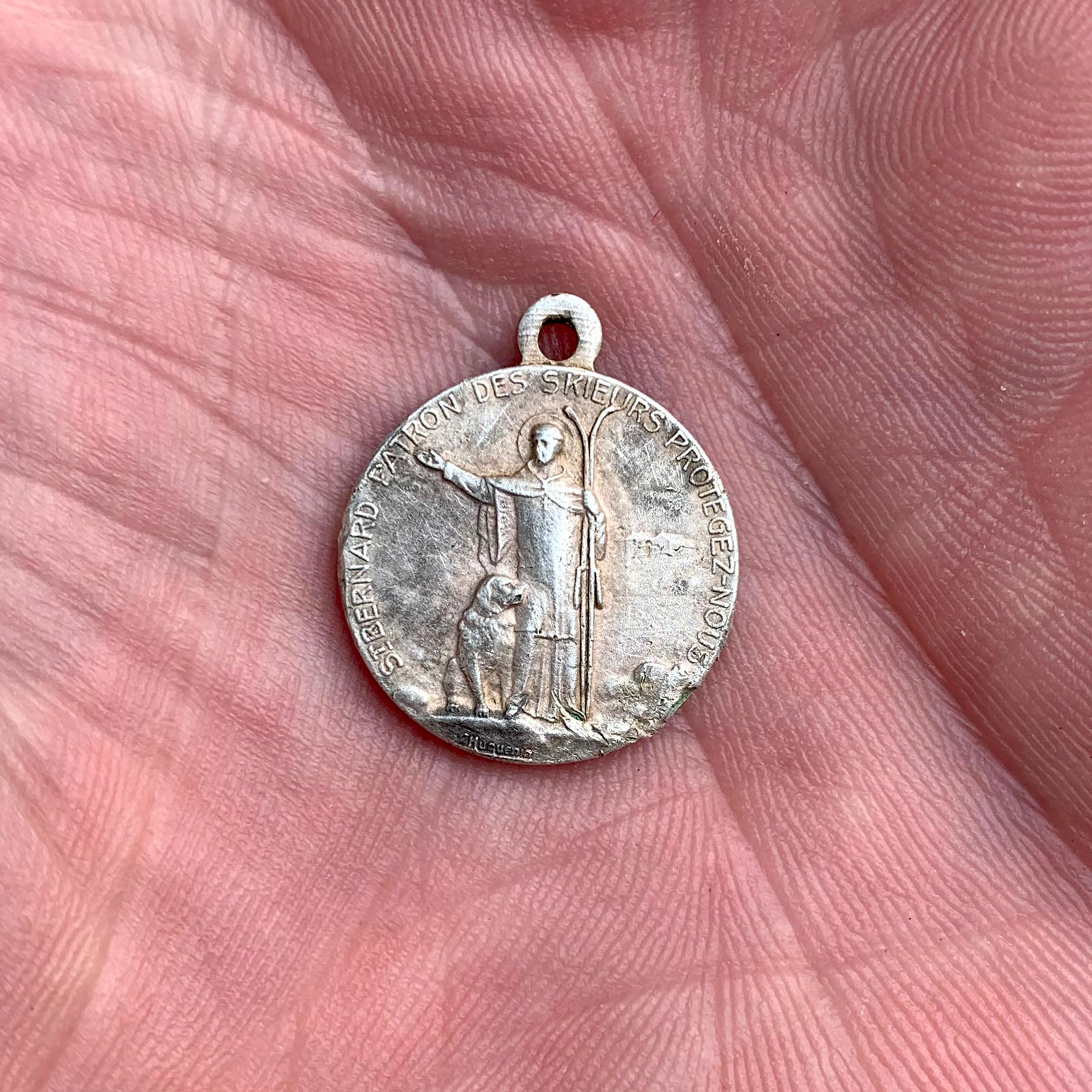
Silver pendant of St. Bernard made by Huguenin.
I also did the same with the second piece of silver that I found as this time it had a direct connection to his family. The silver in question was a pendant of St. Bernard the patron saint of skiers! The pendant had the makers name Huguenin which was a Swiss firm established in 1868. The connection is that previous generations of his family used to spend a lot of time in years gone by skiing in the Swiss Alps. It would also appear that they spent some time skiing on this slope too and I’m sure St. Bernard appreciates seeing daylight again.
We spent quite a lot of time on this field in the months that followed and although we had some other good finds it didn’t really produce in the way we thought it might. I had a couple more Roman coins from it though, one was Marcus Aurelius and the other was Gordian III. I was really chuffed with Marcus Aurelius and I remember on discovering who it was saying, “that’s bloody Richard Harris that is”. I was so chuffed that I insisted that my partner and I watched Gladiator that evening. There we were watching Richard Harris with one of his coins sat on the coffee table and me with a stupid grin on my face. It’s only when I think of it now that I realise that my partner must despair of me at times.

Marcus Aurelius obverse 161-180AD.
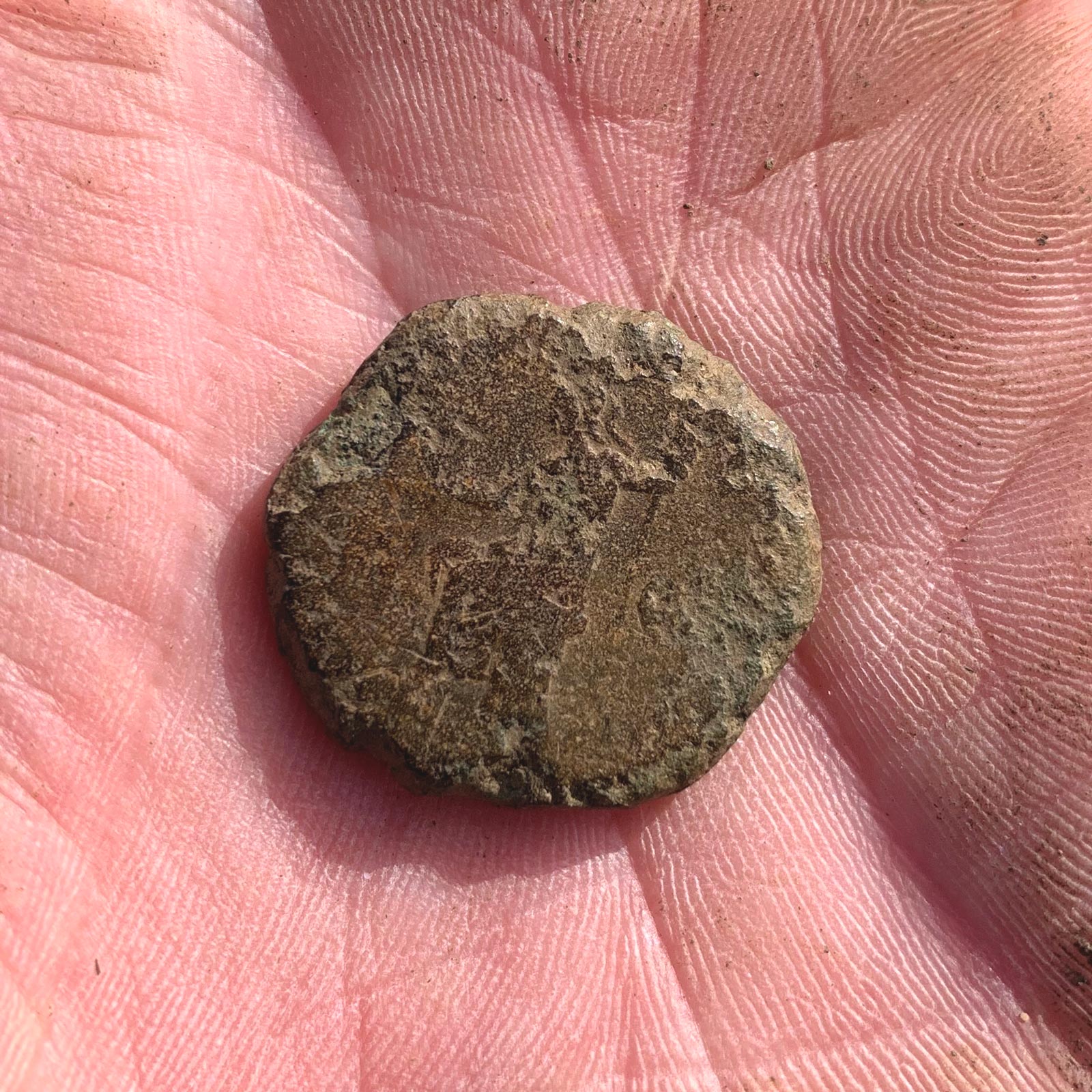
Marcus Aurelius reverse 161-180AD.
So again it was getting to the point where we needed to extend the search elsewhere on the permission. During December my mate didn’t come out as much, and to be honest I didn’t blame him because it had turned pretty darn cold. It was only my hot flask of tea and thermal underwear that kept me out in the freezing temperatures, along with the thought that there must be a Roman hoard around here somewhere. During some email conversations with Julian Evan-Hart, he let slip that Weston is where he grew up, which kinda left me with a feeling of imposter syndrome. But he also divulged that a hoard of silver denaris had been uncovered near the church sometime in the 1800’s. I don’t think any records exist and the whereabouts of the coins is unknown so who knows if it is true, but it has kept my hopes alive of there being another stash of Roman coins around here somewhere.
During this month I took the search closer to the family house, my thinking being that if I were a Roman living on this landscape I would make a home exactly where the family have there home today. The landowner was ok with this so long as I didn’t search directly on the main lawn. It worked for me as I wouldn’t have felt comfortable digging holes in the front garden and the area that I was specifically interested in I was allowed to search. This was a small wooded area to the side of the main house that had some well walked paths and small open grassy areas between some of the trees. But again, nothing Roman, it was mainly more modern coins from the early 1800’s onwards which I guess are probably loses from members of the landowners family over the years. I also found a medal, it turns out it was from the Daily Mail Teddy Tail League celebrating the Silver Jubilee of king George V in 1935.

A collection of relatively modern coins.
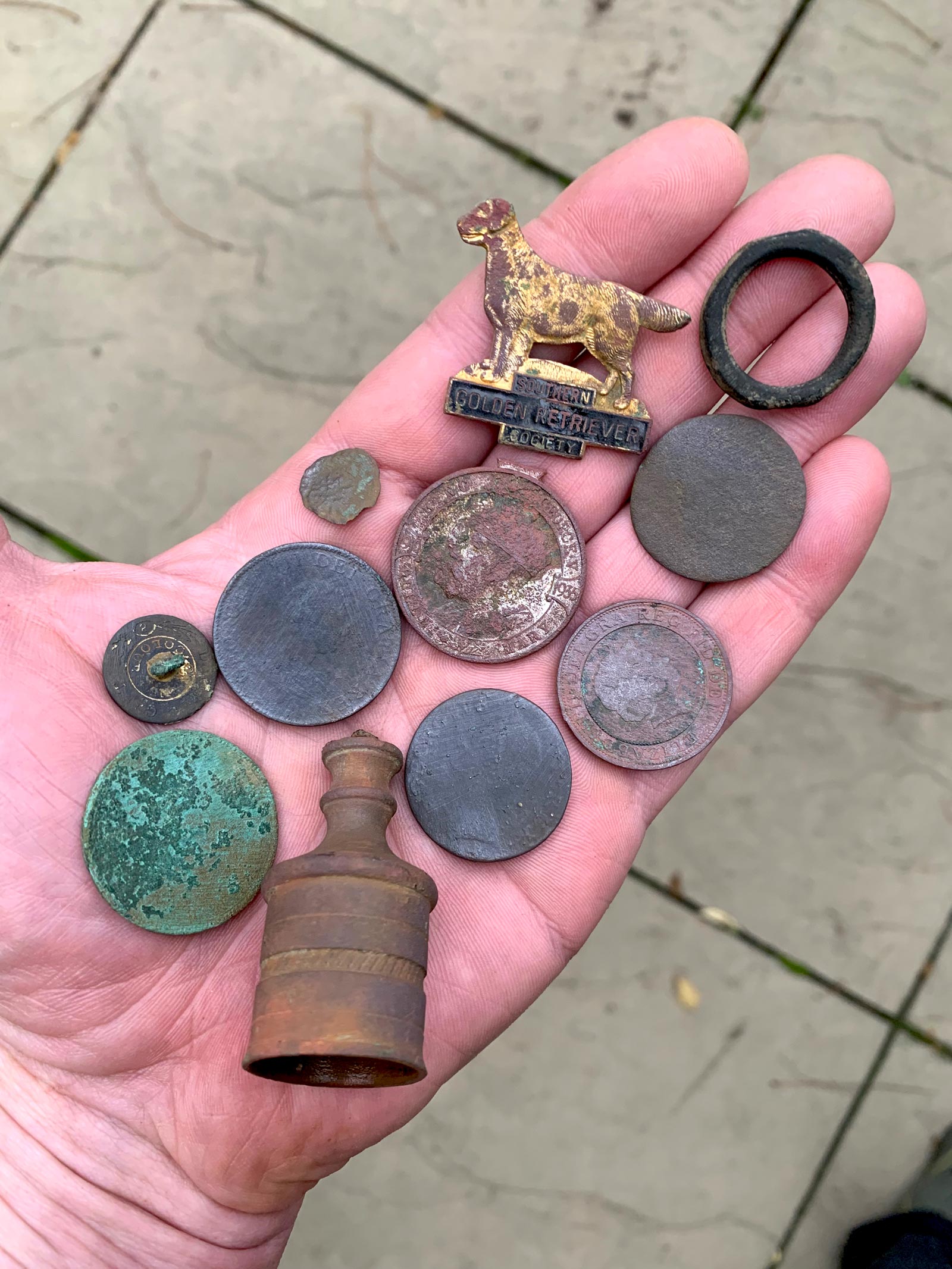
More finds from the woods.
In these wintery months there was also some incredible scenery to take in on the frosty early mornings. It’s another of the great aspects of this hobby, being in the middle of the gorgeous countryside that North Hertfordshire has to offer. It’s these moments when I take the time to stand back and take it all in that I feel incredibly lucky to live in this beautiful part of the county. But beautiful frosty mornings aside, there was no evidence of Romans’ on this part of the permission, so where were they?

A cold frosty morning in Weston.
You might well be thinking that it’s pretty obvious, they were at the villa which is just outside of our permission and you’d be right, they were there. But I had a feeling that there had also been habitation elsewhere on the permission. Part of the reason for this was the research I did on the PAS database. In my previous article I wrote about the help that my Finds Liaison Officer, Matt Fittock gave in using the database to search for finds by grid reference. The results of this were interesting because quite a few Roman finds had been made in the square kilometer that included the Roman villa and some of the land from our permission, but outside of that square kilometer there was pretty much nothing. What interested me is that the earliest Roman finds recorded on the PAS database were from 260AD onwards, nothing before that. The coins I have been unearthing are much earlier than this, the denarius of Hadrian for example dates from 117 to 138AD, so it got me thinking that there might be dwellings in addition to where the villa site is now as my finds were all coming up outside of that square kilometer. This feeling was further enhanced with the occasional small lead pot mend I was finding as these are usually good indicators of habitation.
Between Christmas and new year me and my mate decided to give another field some attention. It’s one we had constant sight of because it was on the opposite side to the main south facing slope we had spent so much time on, but for some reason we didn’t think much of it. This was partly due to the big badgers den that was slap bang in the middle of it, but we managed to overcome that fear as curiosity got the better of us and boy did it pay off!
This field has it’s own entrance and we had permission to park on it which was great, it made things a lot easier should the need to escape angry badgers arise! The finds started coming up pretty quick with a few modern coins including a nice silver George III shilling, and then a little later a toasted Roman coin, possibly a dupondius but I wasn’t able to identify the Emperor. Then came a bucket lister for me, my first Roman fibula brooch, it was a real punch the air moment. Neither of us had ever found a fibula brooch and my mate has been detecting a lot longer than me, it even led to us dancing a little jig. The brooch was broken as they usually are but it still had a good portion of the spring mechanism which was good for dating purposes. As with a lot of my finds I ran this one past Keith Fitzpatrick-Mathews, the Curator and Heritage Access Officer at North Herts Museums and he dated it 40-60AD. So the dates of our Roman finds are now being placed at the beginning of the occupation which probably meant there was habitation here before that. There is one Iron Age brooch on the PAS database recorded from this area so maybe in future outings we will find our own evidence of Iron Age habitation.
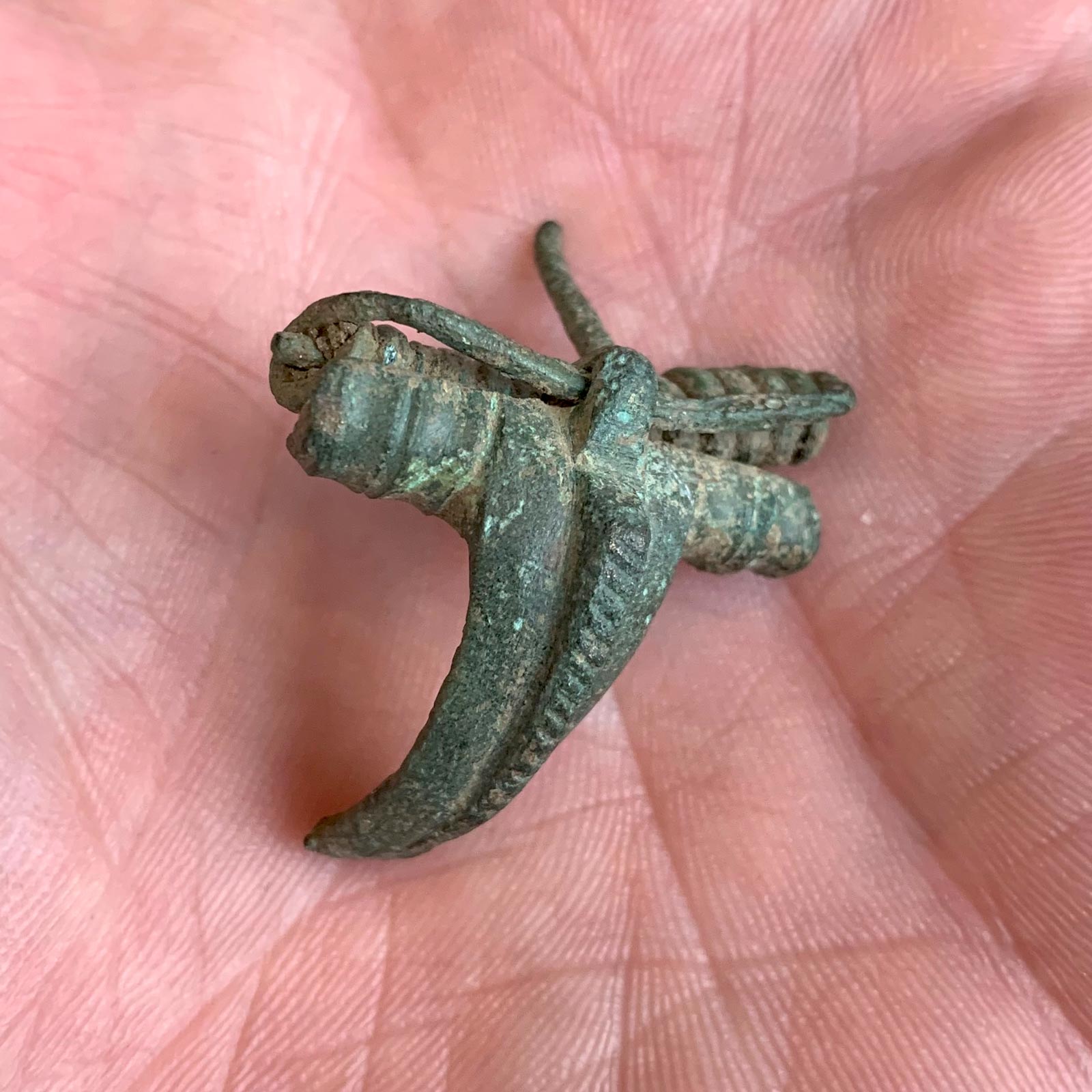
Roman Fibula Brooch dated 40-60AD.
My next time out on this field was New Years Day, but my mate was unable to join me so I was on my own for this one and he kinda regrets not coming out to play now. This was when the Roman coins started popping up in abundance, I think I had 9 come up in total on that day and all in close proximity to each other. I came back the next day, as you would, and again my mate couldn’t make it and I had another 10 coins out. It’s at his point I started to wonder if we had the beginnings of a hoard clipped by the plough, but in the next few outings when my mate could make it the coins started to become a lot more scarce. We had 39 coins in total between us, not a hoard but still a bloody good start to the year! The majority of these were toasted but there were quite a few that could be identified and dated.
On handing the coins in to Matt Fittock (FLO) I asked if he would be able to identify some of them there and then, but he was unable to because of the massive backlog of work he has to contend with due to our hobby becoming more popular during the lockdowns. I decided to try and identify them myself using the book ‘A History of Roman Coinage in Britain’ by Sam Moorhead the National Finds Adviser for Iron Age and Roman Coins at the Portable Antiquities Scheme (British Museum). I think I did ok but I wanted someone to check my homework to be sure of my efforts. I decided to be a bit brazen and I emailed Sam Moorhead directly and he very graciously replied having marked my homework. I had sent him a pdf with photos of both sides of each coin with my identifications and I didn’t fare too bad. There were a few I got wrong which he corrected and he also left a note next to one of them saying ‘nice coin’. I asked why he had singled out this particular coin (Constantine II) to which he replied “The bust with the emperor holding Victory on globe is scarce; it’s also a nice coin to look at!” It’s a pretty good feeling to be told that at least one of these coins a little on the rare side.
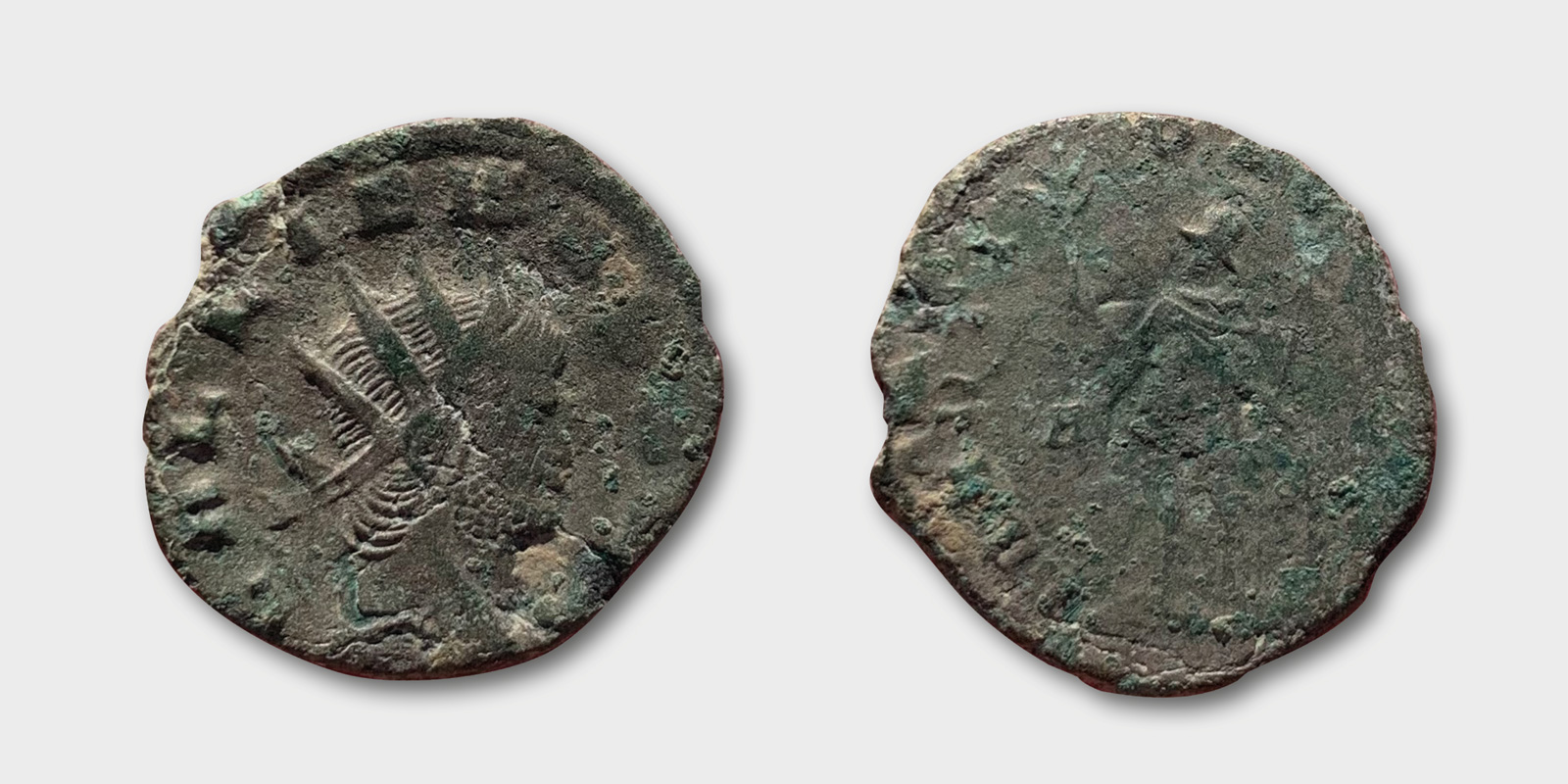
Gallienus 260-68AD.
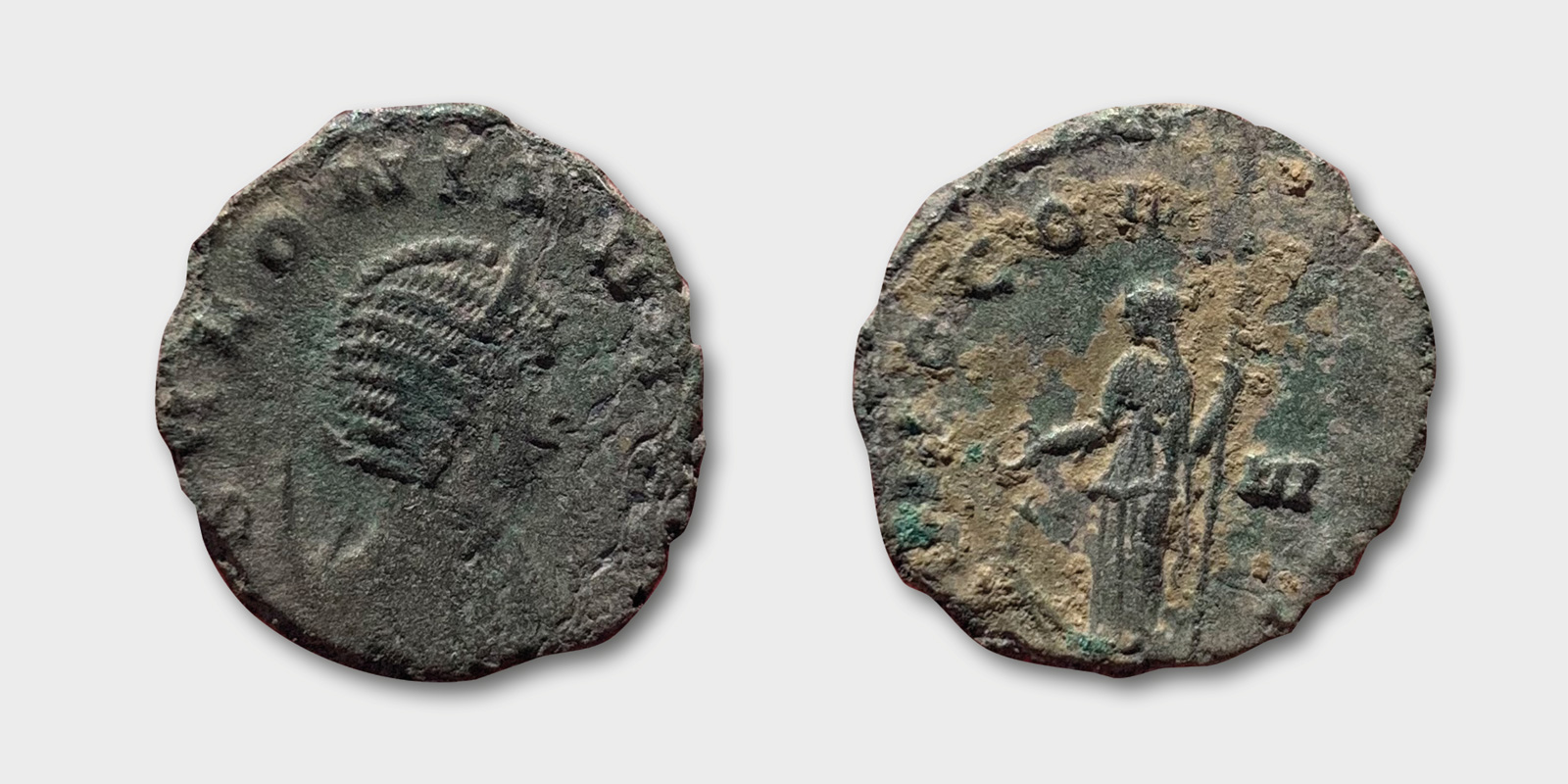
Salonina 260-68AD.
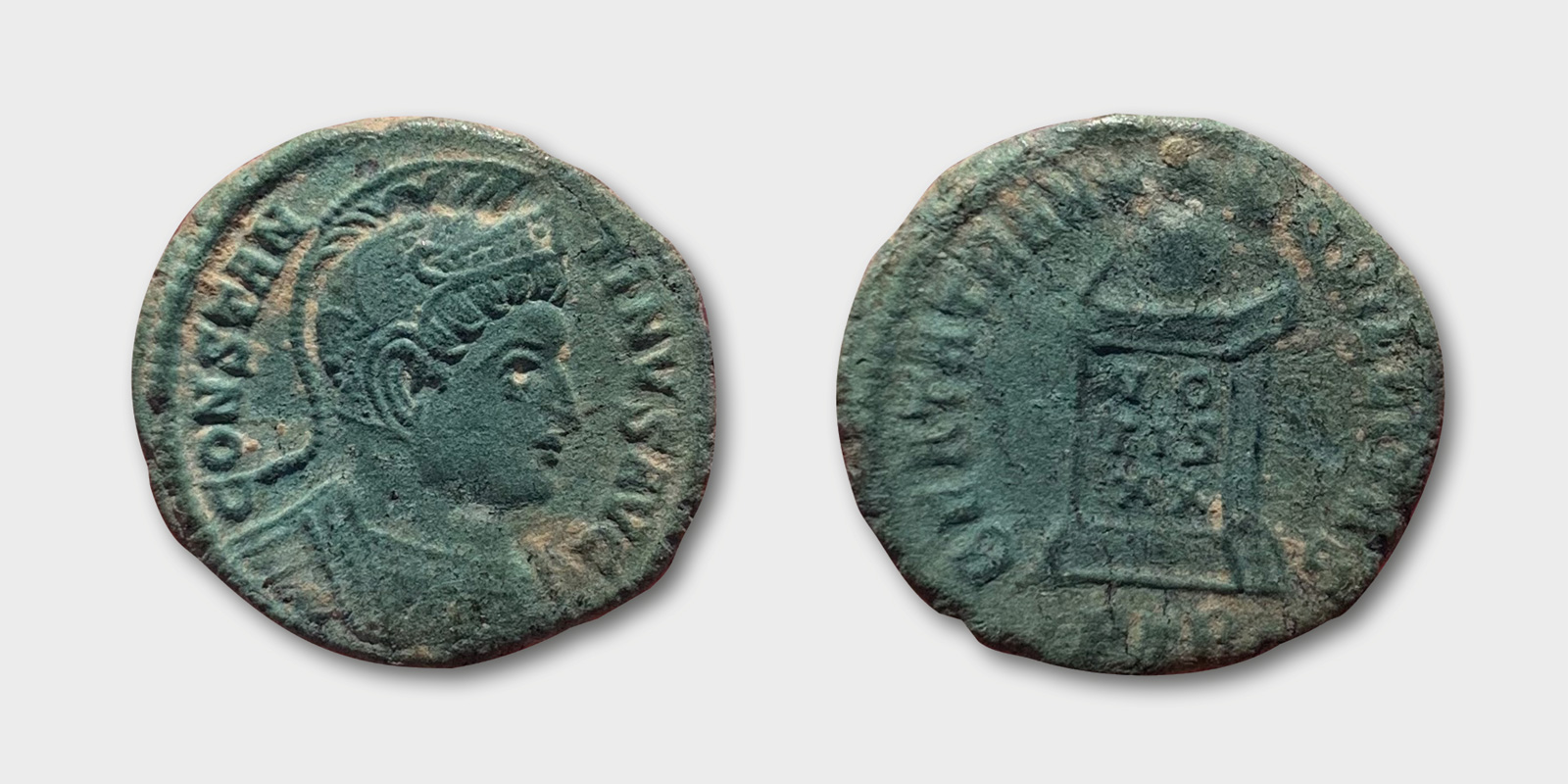
Constantine I 306-37AD.
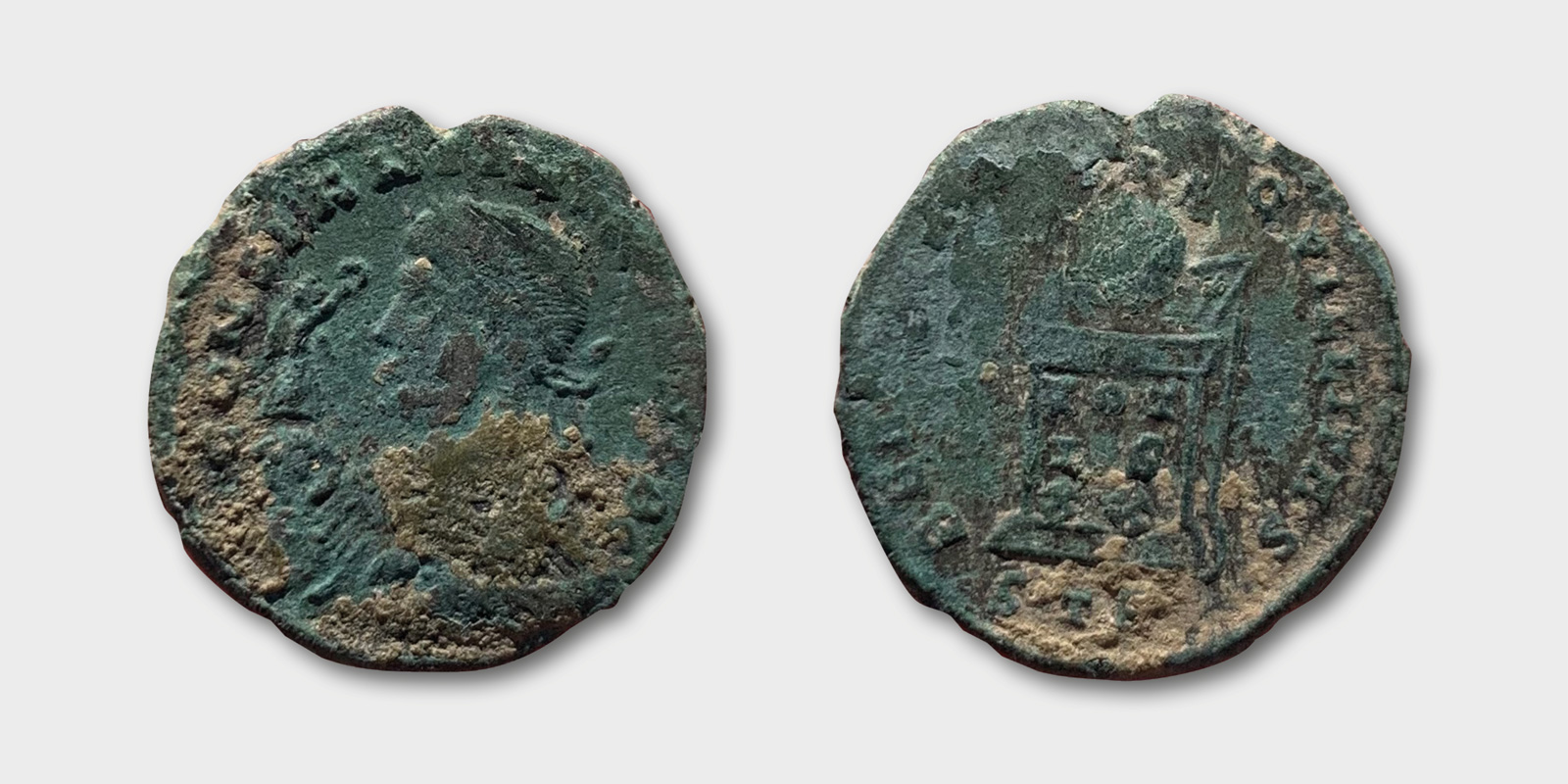
Constantine II 317-37AD.

Constans 337-50AD.
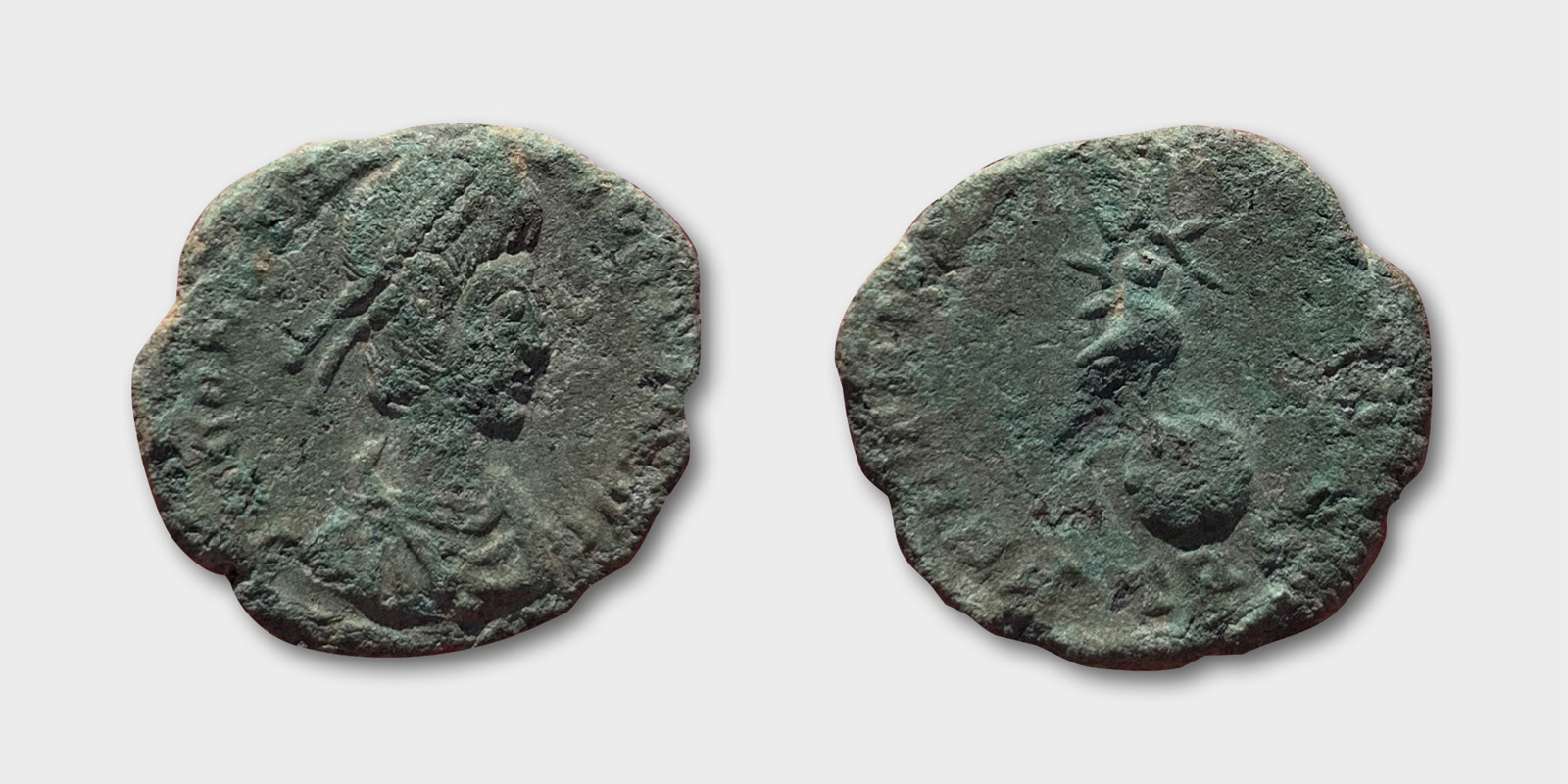
Constans 337-50AD.
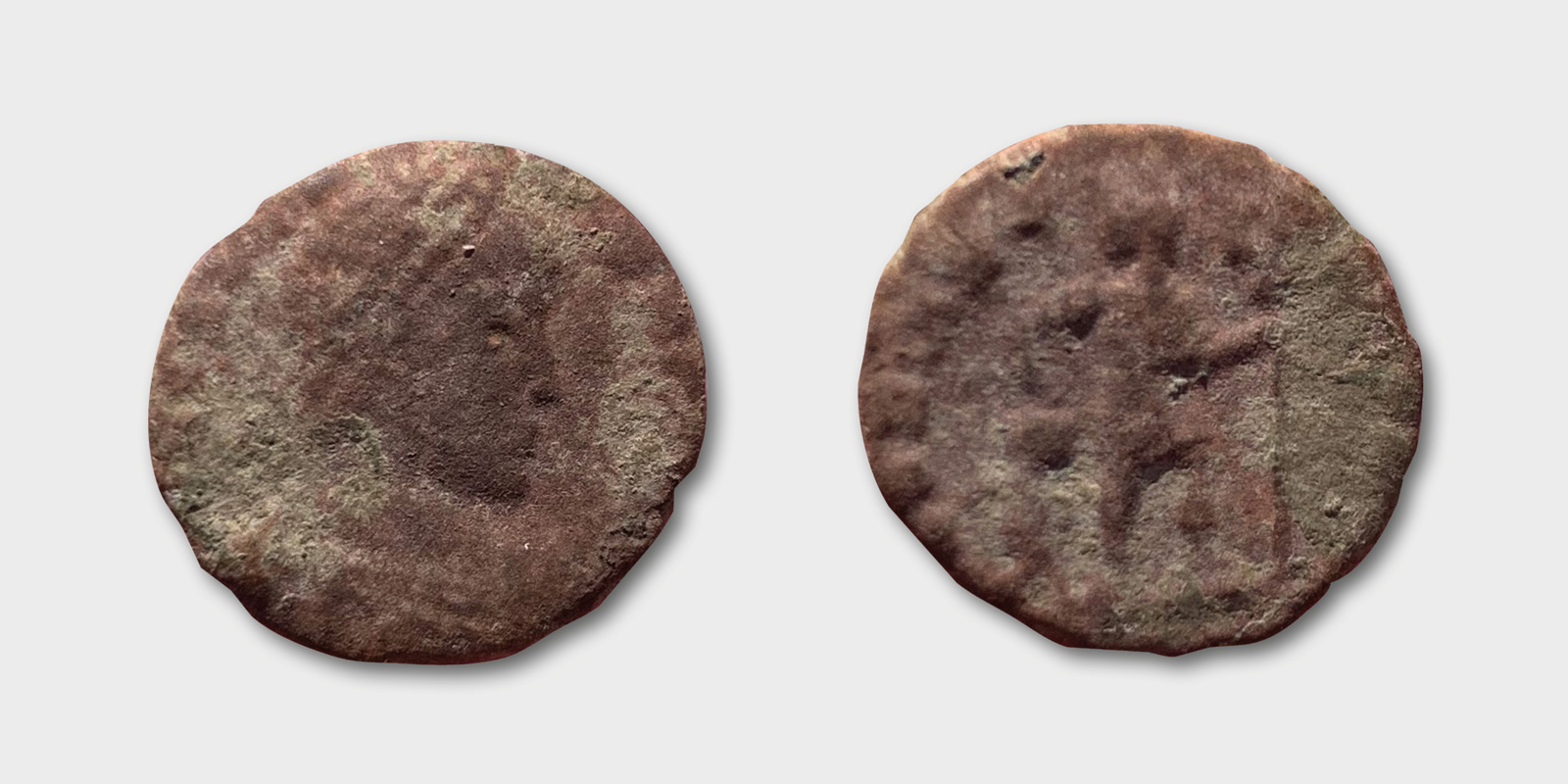
Valens 364-78AD.

Gratian 367-83AD.

Gratian 367-83AD.
So now I was able to identify the dates of the coins which range from 260-383AD, a good spread spanning well over 100 years of the middle to later end of the Roman occupation. It’s interesting to note that these coins don’t date below 260AD and they were found bang on the border of the square kilometer that I talked about. But there was one coin I was unable to identify using Sam’s book and it turns out there was a very good reason for that, it wasn’t bloody Roman! The coin in question was actually Iron Age, a bronze unit of Cunobelinus (ABC 2969) to be exact, which is great as it means we have our first piece of evidence of habitation before the Roman occupation. It’s quite probable that this site had Iron Age inhabitants that later transitioned to a more Roman way of life and hopefully future finds will further support this.
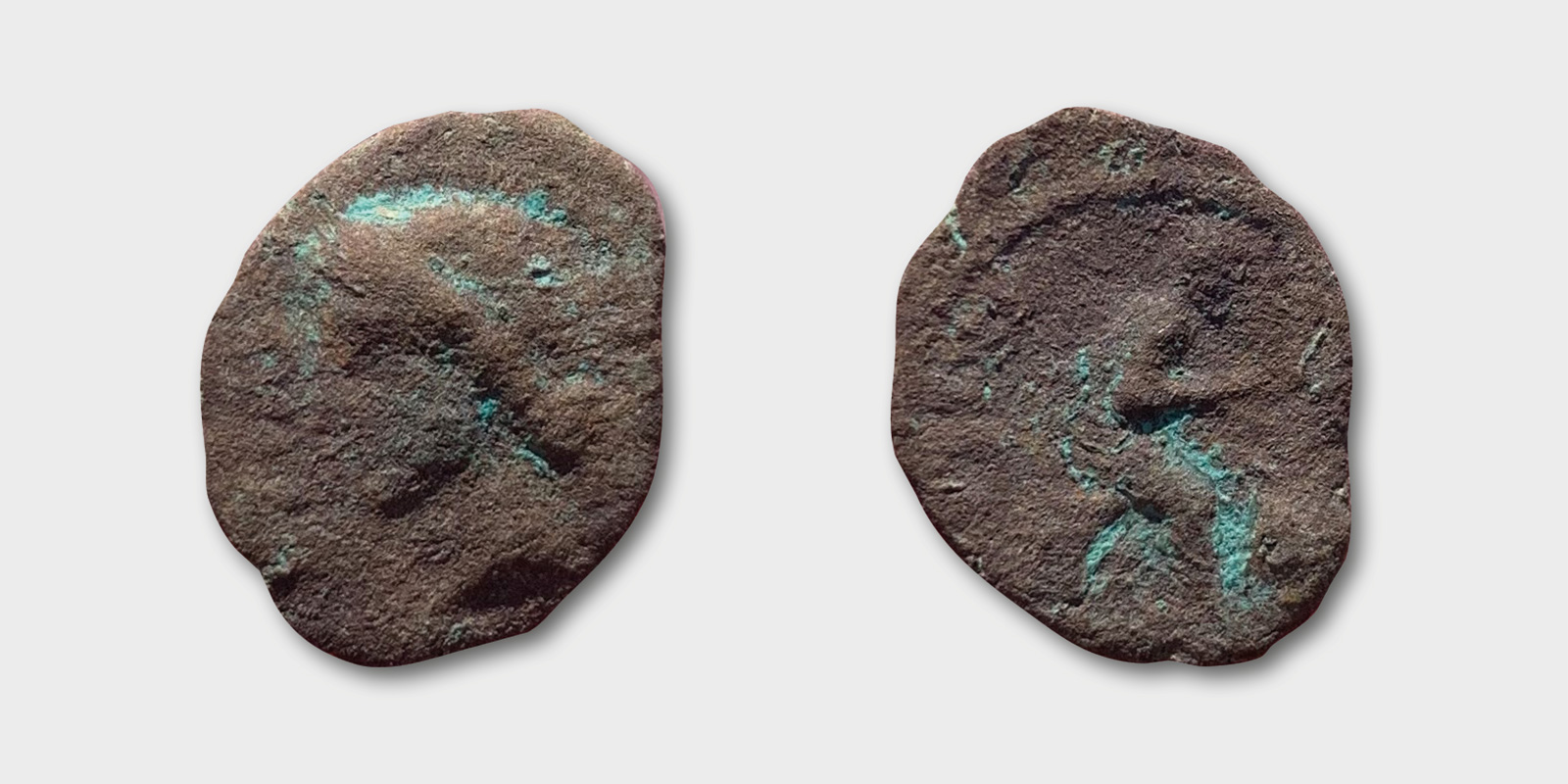
Iron Age bronze unit of Cunobelinus 10-40AD.
So what are these finds telling us about this particular area? It’s worth noting that the villa in the neighbouring field was thought to be constructed with a low sill of flint and mortar with a timber frame on top with a tiled roof. Previous field waking searches produced evidence of this which led to the site being scheduled. The digging where our finds are coming up is constantly hindered by a lot of flint, tile and iron nails, is it possible there was a Roman building of some sort here as well? Because the field is pasture you can’t see any evidence of this on the surface by doing a field walk. So I decided to ask Keith if he thought it was plausible that a roman building might have been here and if not what other reason might there be for these finds coming up in the same place?
“Roman villa estates were dominated by the big house where the landowner (or his bailiff) and their family lived. But they were not the only buildings. Sometimes the villa would have a detached bath-house or a shrine to a local god and even small structures in their gardens that could have been the equivalent of summerhouses or gazebos. Sometimes, villa buildings come in pairs, often at right angles to each other. But the owners were too grand to farm their estates themselves. Instead, they had slaves or tenant farmers to do the hard work. Their homes would be away from the main villa, perhaps even hidden from view by tall hedges or plantations.”
Keith carried on to say, “What you’ve discovered could be any of these, if it is part of the villa estate. It’s also possible that you’re looking at a neighbouring property, a separate settlement that wasn’t part of a villa estate or maybe a religious site. I think that this is less likely, though, and that what you’ve found is another substantial building on the estate of the known villa.”
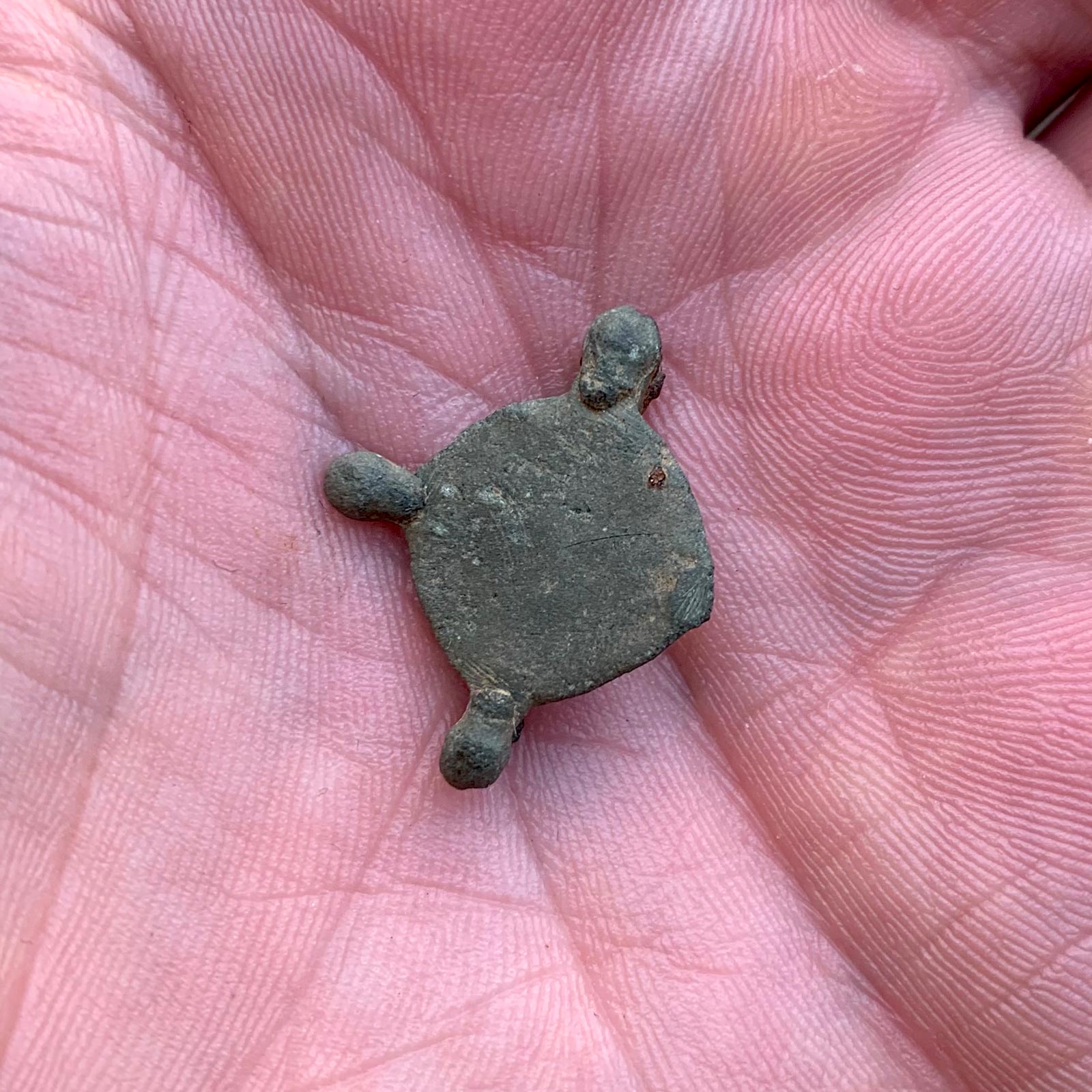
Remains of a Roman plate brooch.
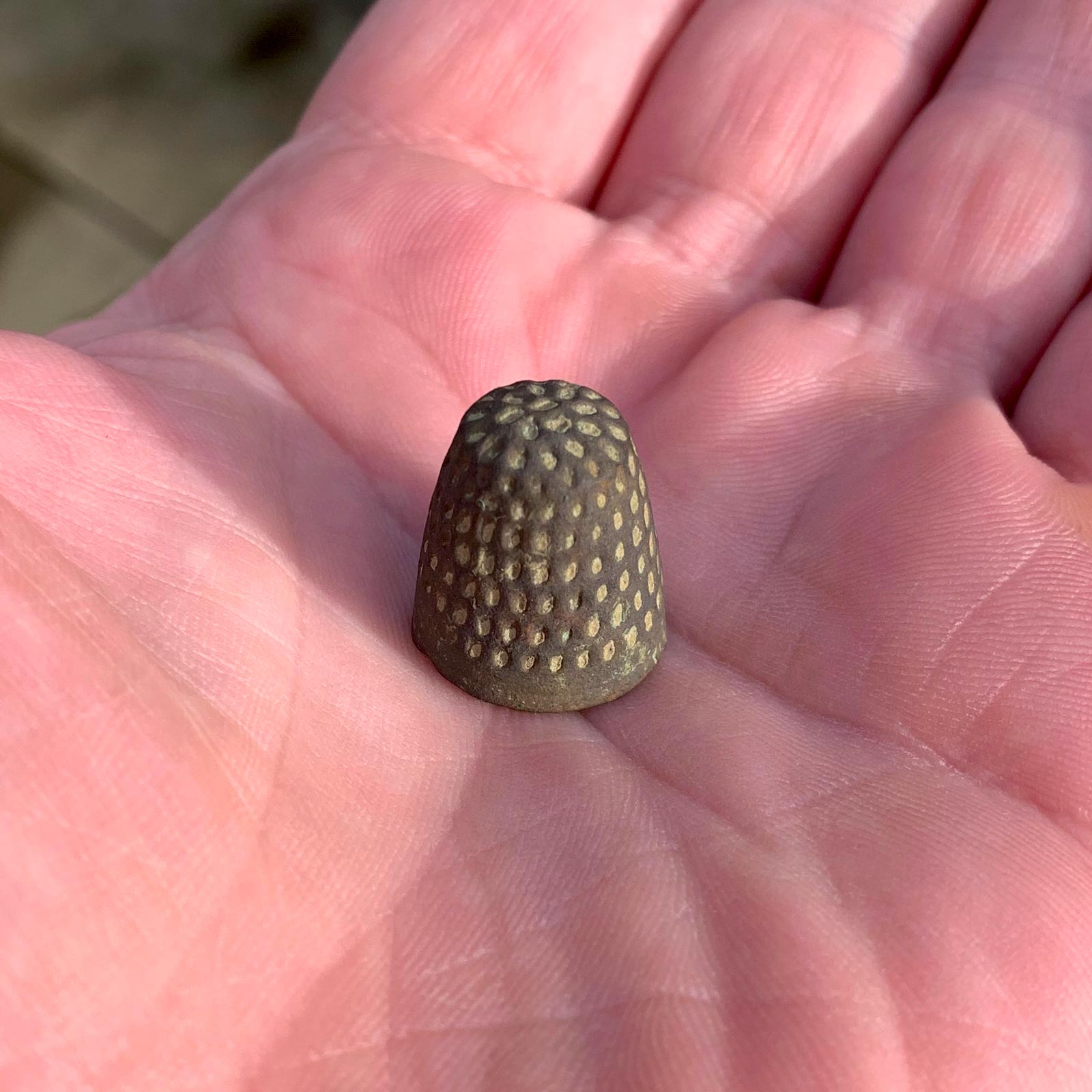
A lovely 16th Century thimble.
So it appears we may have stumbled on another potential Roman building, very exciting stuff and hopefully we will find more evidence of this as the detecting journey here continues. A few other bits and bobs have come up on this field including my first hammered coin from this permission, a lovely 16th century thimble and the remains of a Roman plate brooch. I also had another bucket lister, my first matchbox car! It’s nothing as grand as a Ford Mustang or Pontiac Firebird but a Kenworth Racing Rig will do very nicely.
My time on this permission is on going so if you want to keep up to date with the things that I find then you can follow my Instagram account where I post the majority of the stuff found from here, so just click on the link below. 🙂
